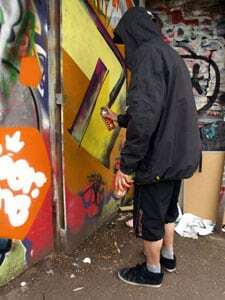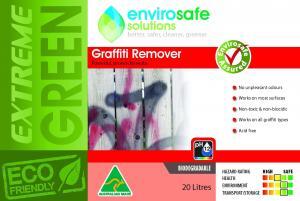Whether graffiti is art or vandalism may lie, like beauty, in the eyes of the beholder. Yet this urban scrawl – which appears on public buildings and amenities in every town and city – is a financial burden for councils and business operators forced to remove it. South Australia’s police chief has called for a HECS-style debt payment plan for graffiti vandals. Today we look at this graffiti, its environment impact and an eco-friendly liquid product which successfully removes it.
South Australian police commissioner Mal Hyde has called for graffiti vandals to foot the clean-up bill from their work once they have an income.
The plan is similar to the HECS-style payment plans available to university students.
In a submission to the State’s attorney general, Mr Hyde said the compensation would help recoup the expensive clean-up bill left by graffiti. He said courts often failed to order minors to pay removal costs because they were obliged to consider the offender’s ability to pay.
“The offender should retain an obligation to pay compensation in a similar way that a tertiary student has a long-term compulsion to pay the Commonwealth Higher Education Contribution Scheme (HECS). An offender may not have the means to pay compensation at the time of the offence but may have the means many years later.”
Councils spend millions of dollars each year to remove graffiti – for the Adelaide City Council alone this bill was $338,000. The City of Charles Sturt removed 9173sq m of graffiti in 2009/10 or 14,235 ‘tags’. This cleaning process itself often strips original paintwork, costing more time and money, although this risk can be reduced by using an environmental cleaning product such as the Extreme Green Graffiti Remover.
Counting the environmental cost
Solvent-based spray paints leave an environmental legacy. The production of spray paints creates highly toxic wastes, which bio-accumulate and must be carefully managed. Rapidly drying spray paints favoured for graffiti often contain more toxic solvents than house paint.
Removing graffiti tags involves the use of chemical cleaners or eco-friendly industrial liquid and high-pressure water sprays, which draw on valuable water resources and add to contamination of waterways.
Removing offending graffiti ‘tags’
Youth advocates have argued for dedicated spaces for graffiti tags, where new work could simply be painted over any offending tags, eliminating the need for any clean-up. Others believe this approach would fail to prevent graffiti vandals from defacing public and private property.
The task of removing graffiti – which falls heavily on councils, business operators, schools and other public bodies – has traditionally involved contact with toxic harsh acids. An alternative eco-friendly industrial liquid has been designed to offer users a safe, sustainable yet powerful multi-purpose graffiti remover.
The Extreme Green Graffiti Remover (formerly Exit Tag) effectively removes spray paint, ink, permanent texta, whiteboard markers, crayon and liquid paper on a wide range of hard surfaces. It works quickly – needing less than three minutes to penetrate – to reduce the risk of damage to any original paintwork.
Its non-toxic formula contains user-friendly non-hazardous solvents, making it safer to use and better for the environment. For more information on the cost-effective Extreme Green Graffiti Remover or other environmental cleaning product contact Perth-based Envirosafe Solutions 1300 88 90 70 or email info@evss.com.au.
Sources:
http://wiki.answers.com/Q/Why_is_graffiti_bad_for_the_environment





















